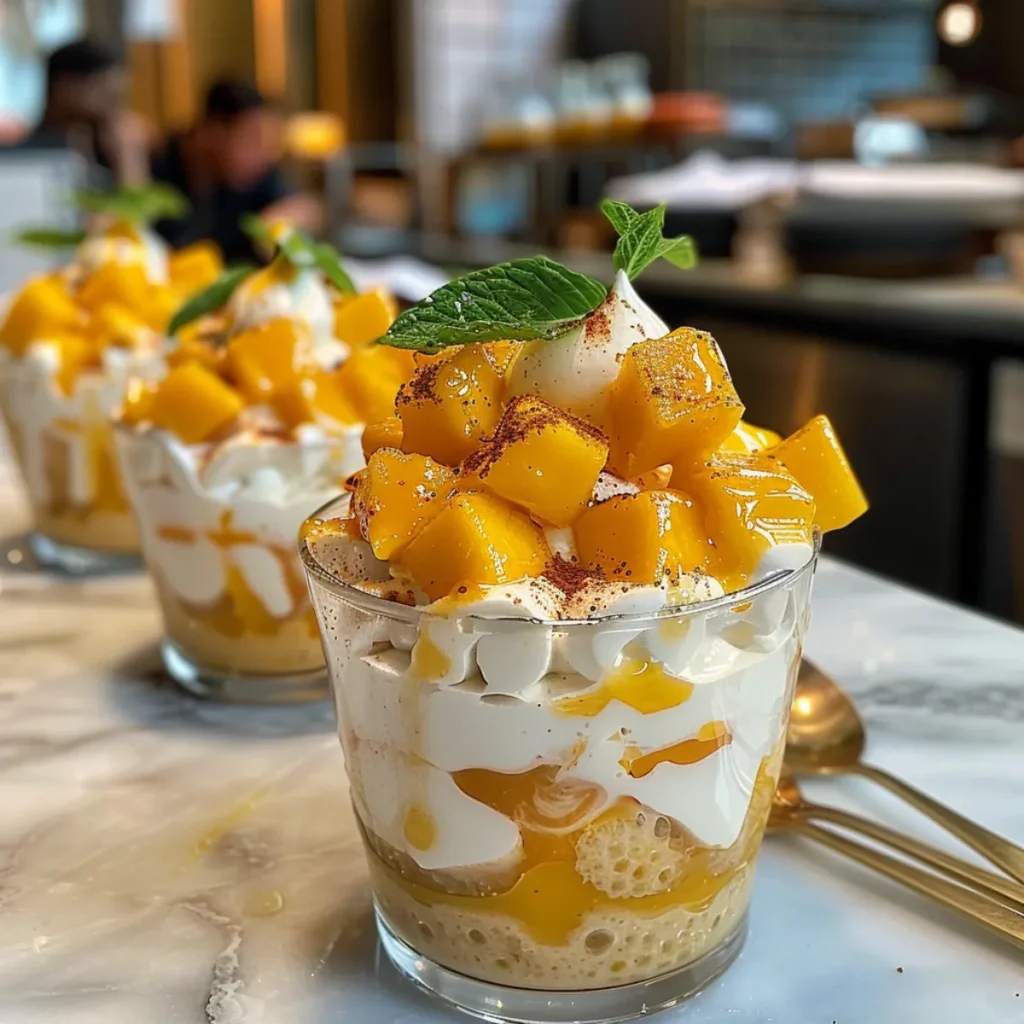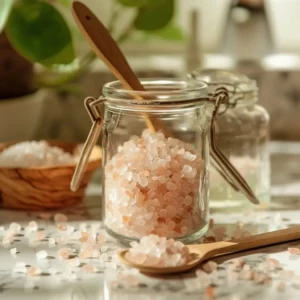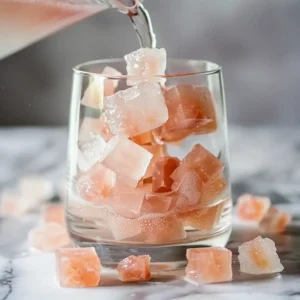Mango Sago has always been one of those desserts that makes me pause and smile. It’s creamy, chilled, and fruit-packed—everything I crave when the sun’s out or when I just want something refreshing and light. This tropical treat, a beloved dessert across many parts of Asia, is more than just a mix of mangoes and sago pearls. It’s comfort in a bowl, especially when you’ve made it just right.
In this article, I’ll take you through everything you’ve ever wanted to know about mango sago—from its origins and cultural roots to how you can make it right at home. Along the way, I’ll share how I first discovered it on a humid afternoon in Singapore and how it quickly became a staple in my kitchen back home.
We’ll break down what mango sago is made of, the difference between sago and tapioca, regional variations, nutritional insights, and even smart storage tips. You’ll also find answers to the most commonly asked questions and discover related recipes to explore more tropical dessert ideas.
Let’s begin with the roots of this iconic dessert.
The Sweet Origins of Mango Sago
What’s the Story Behind Mango Sago?
I still remember the first time I tasted mango sago—it was at a bustling food court in Hong Kong. The air was heavy with the scent of roasted duck, steamed buns, and sweet fruits. But it was the cool, creamy mango sago that stood out. It felt like a tropical breeze in dessert form.
Mango sago is believed to have been created in the late 1980s by a chef at the high-end Hong Kong restaurant Lei Garden. The idea was to introduce a modern, refreshing dessert that balanced East and West flavors. What emerged was a beautiful blend of puréed ripe mangoes, chilled coconut milk, evaporated milk, and translucent sago pearls.
Though the origins are fairly recent compared to centuries-old desserts, mango sago has quickly earned its place as a beloved treat across Asia—especially in places like Singapore, Malaysia, Taiwan, and the Philippines. It’s often served in dessert cafes, dim sum spots, and even home kitchens as an elegant but easy dish that cools the body and delights the palate.
This dessert wasn’t just made to satisfy a sweet tooth—it was designed to embody tropical joy, using locally available ingredients and a creative, almost artistic presentation. Its popularity exploded because of its flexibility and minimal ingredients.
How This Dessert Became a Modern Asian Favorite
Over time, mango sago moved beyond Hong Kong and became a staple in many Southeast Asian countries. Each region added its own twist. In the Philippines, for instance, you might find it with condensed milk or bits of jelly. In Taiwan, it’s sometimes served frozen like a smoothie. The simplicity of its base allowed for countless adaptations without losing its identity.
What made it spread so rapidly? The answer is simple: it hits all the right notes. Sweet, creamy, chewy, fruity, and cold. Plus, it looks beautiful in a bowl or glass—sunny yellow mango contrasted with pearly white sago beads. For a dessert that’s quick to assemble but high on flavor and satisfaction, it doesn’t get better than this.
Restaurants, food bloggers, and even big dessert chains have jumped on the mango sago trend, incorporating it into fusion menus and reimagining it for newer generations. But at its heart, mango sago remains a humble, heartfelt dessert born from tropical ingredients and culinary creativity.
Ready to explore what makes this dessert so special in its core makeup? Let’s unpack what mango sago is made of next.
What is Mango Sago Made Of?
Essential Ingredients in a Classic Mango Sago
Let’s get to the heart of the dessert—what exactly goes into making mango sago? The beauty of this tropical treat lies in its simplicity. With just a few core ingredients, you can create something truly magical. Here’s what you’ll typically need:
- Ripe Mangoes: The star of the show. You want sweet, fragrant mangoes—Ataulfo, Alphonso, or even Tommy Atkins will do. Fresh mango purée gives the dessert its rich yellow color and unmistakable flavor.
- Sago Pearls: These tiny, chewy balls are made from the pith of the sago palm. When cooked properly, they turn translucent and provide that delightful bounce in every bite.
- Coconut Milk: This adds creaminess and a subtle tropical aroma. It plays beautifully with the sweetness of mango.
- Evaporated Milk: Often used to balance out the richness and provide a velvety texture.
- Sugar: Optional, depending on how sweet your mangoes are. A touch can amplify the overall flavor.
- Ice or Cold Water: Some recipes blend ice into the mix or chill the dessert with a bit of crushed ice to enhance the refreshment factor.
That’s it. No fancy gadgets, no hard-to-find ingredients. Just a handful of tropical pantry staples and a bit of patience.
How Each Ingredient Adds to the Taste and Texture
What makes mango sago so enjoyable isn’t just the ingredients themselves, but how they work together.
- Mangoes bring natural sweetness and tropical flair. The fiber-rich flesh also adds body to the purée.
- Sago pearls are neutral in taste but provide that chewy, bouncy texture that contrasts with the smoothness of the mango and milk.
- Coconut milk introduces fat and creaminess, adding a subtle richness that’s not overwhelming.
- Evaporated milk balances the coconut and gives the dish a café-style sophistication.
- Sugar, when used, simply rounds out the flavors without overpowering.
When served cold, every spoonful becomes a contrast of smooth, chewy, and creamy. It’s that multi-textural experience that keeps you coming back for more.
Next, we’ll dive deep into the pearls of the dish: sago. Let’s demystify what it is and how it differs from tapioca.
All About Sago – The Pearls of the Dish
What Exactly is Sago and Where Does It Come From?
Sago often gets mistaken for its chewy cousin tapioca, but it has its own story—and texture. It’s a starch extracted from the pith of various tropical palm trees, especially the Metroxylon sagu, which is native to Southeast Asia. The starch is processed into small white pearls, and when boiled, they become transparent with a soft, jelly-like bite.
I first came across real sago pearls during a trip to Indonesia. Watching them extract starch from the palm trunk in a rural village was nothing short of fascinating. The process is labor-intensive, but the result is a versatile starch that’s been used for generations across Asian and Pacific cuisines. In fact, sago has traditionally been a dietary staple in some communities, especially in places like Papua New Guinea and Malaysia.
In mango sago, these little pearls take on a different role. They’re not there to fill you up—they’re there to surprise your palate with each spoonful. Soft, chewy, and totally neutral in flavor, they absorb the richness of the coconut milk and mango purée around them.
Is Sago the Same as Tapioca? Key Differences Explained
Here’s where things get tricky. In many recipes, especially outside Asia, the term “sago” is used interchangeably with “tapioca pearls.” But while they may look and taste similar when cooked, they’re made from completely different sources:
| Feature | Sago | Tapioca |
|---|---|---|
| Source | Palm stem pith | Cassava root |
| Texture (cooked) | Slightly softer, more delicate chew | Slightly firmer, gummy chew |
| Shape | Smaller, more irregular pearls | Uniform pearls (often larger) |
| Traditional regions | Southeast Asia, Pacific Islands | South America, globally produced |
In a pinch, tapioca pearls can be used in place of sago, especially in Western countries where sago may be harder to find. But if you’re after authenticity, traditional sago offers a more delicate mouthfeel.
Next up, let’s look at how different countries have made mango sago their own, adding unique regional flair to this beloved dessert.
Mango Sago Variations Across Asia
Hong Kong-Style Mango Sago with Evaporated Milk
The original mango sago, as I mentioned earlier, hails from Hong Kong—and it shows. This version is often served chilled in dessert shops and tea houses, usually featuring a bright mango purée base, soft sago pearls, and a generous pour of evaporated milk. What sets it apart? That creamy, dreamy mouthfeel that doesn’t overpower the mango flavor.
Some Hong Kong versions even use mango chunks and pomelo sacs, which add bursts of citrusy bitterness to balance the sweetness. This combo is sometimes called “Mango Pomelo Sago” and is a must-try if you want a more complex twist on the original.
Personally, I love the harmony in the Hong Kong-style rendition. The evaporated milk softens the edges of the fruit while the sago gives each bite a pleasant chew. It’s like sipping on sunshine.
Filipino, Singaporean, and Thai Twists on Mango Sago
As mango sago made its way across Asia, local cultures added their own ingredients and flair:
- Philippines: Here, mango sago is often richer and a bit more indulgent. Sweetened condensed milk or all-purpose cream is typically used instead of evaporated milk. It may also include jelly cubes, nata de coco, or even bits of gulaman (a jelly made from seaweed). It’s the kind of dessert you’d find at birthdays or fiesta tables.
- Singapore: The Singaporean version is close to the Hong Kong style but often lighter and a little less sweet. It’s usually served cold with shaved ice and topped with fresh mango cubes or even aloe vera chunks.
- Thailand: Known for embracing coconut milk in desserts, Thai variations lean more into tropical flavor. You might find mango sago topped with coconut cream, toasted sesame seeds, or mixed with sticky rice—a hybrid between two iconic sweets.
Each of these versions brings something beautiful to the table, yet they all retain the soul of mango sago—chilled, creamy, and brimming with tropical fruit.
Next up, let’s roll up our sleeves and make this dessert in your own kitchen. I’ll walk you through a step-by-step process that’s both beginner-friendly and delicious.
How to Make Mango Sago at Home
Step-by-Step Guide to Creating the Perfect Mango Sago
Making mango sago at home isn’t just easy—it’s downright therapeutic. There’s something incredibly satisfying about boiling the pearls, blending the mangoes, and watching it all come together in one sunny bowl. Here’s my go-to method that I’ve fine-tuned over several tries in my little kitchen.
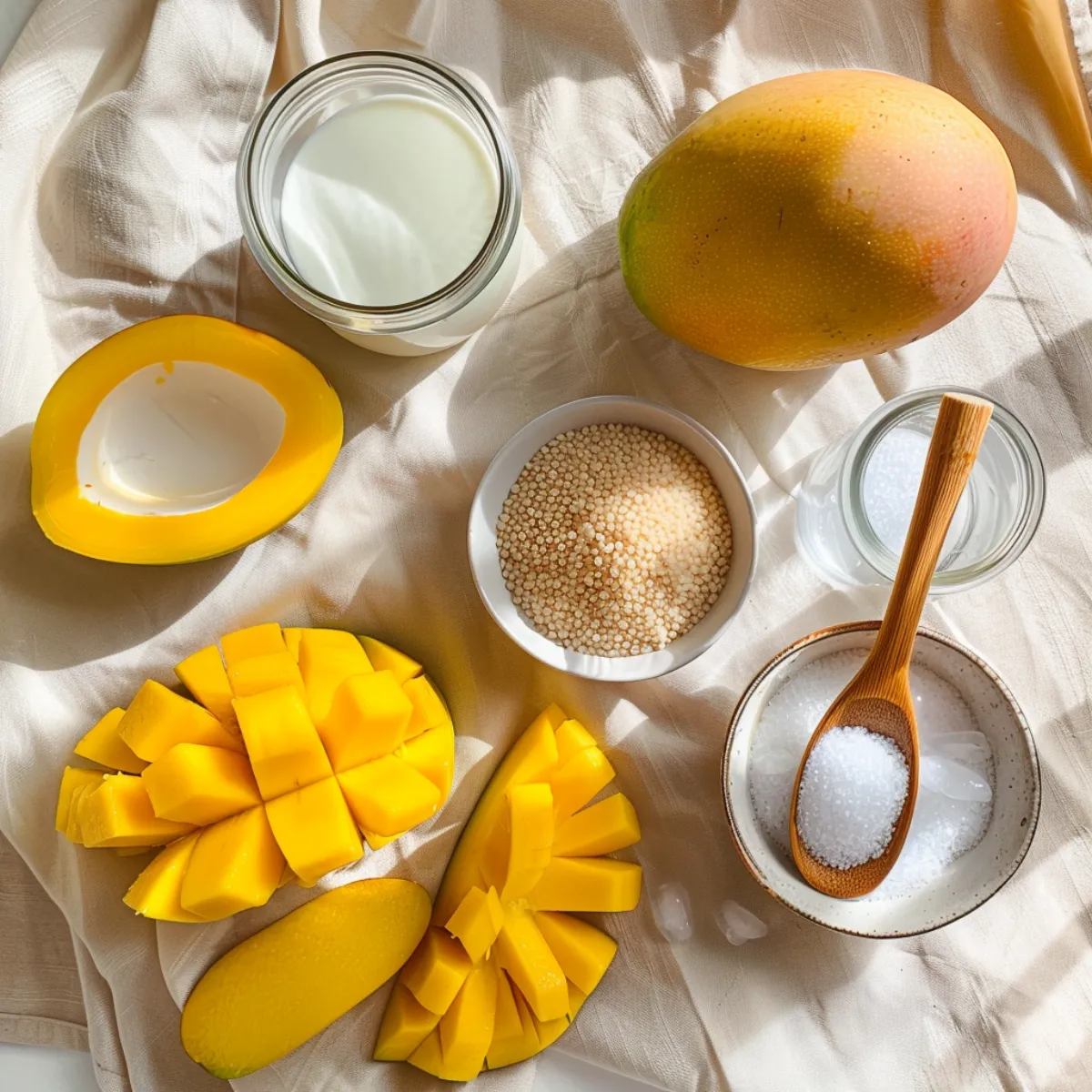
Ingredients:
- 2 large ripe mangoes (peeled, diced, and puréed)
- ½ cup small sago pearls
- 1 cup coconut milk
- ½ cup evaporated milk
- 1–2 tbsp sugar (optional)
- 1 cup cold water or crushed ice
- Extra mango cubes for topping
Instructions:
- Cook the Sago Pearls
Bring 4–5 cups of water to a boil in a medium pot. Add the sago pearls and stir gently to prevent sticking. Let it boil for 10–15 minutes or until the pearls become mostly translucent with a small white center.
Turn off the heat and cover the pot. Let the pearls sit for another 10 minutes to finish cooking in residual heat.
Rinse under cold water and strain to remove excess starch. Set aside. - Prepare the Mango Purée
While the sago is cooking, blend 1½ mangoes with coconut milk and sugar (if using). You want a smooth, rich purée. - Combine Everything
In a large bowl, mix the mango purée with evaporated milk and cold water or crushed ice. Stir in the cooked sago pearls. Let it chill in the fridge for at least 30 minutes before serving. - Serve and Garnish
Spoon into glasses or dessert bowls. Top with reserved mango cubes, and if you like, a splash of coconut cream.
That’s it—your tropical escape is ready to serve!
Tips to Get the Right Consistency and Sweetness
- Taste your mangoes first. If they’re already super sweet, you might not need sugar at all.
- Avoid overcooking sago. Once they’re translucent, pull them off the heat. Overcooked pearls become mushy.
- Chill before serving. Mango sago tastes infinitely better cold. Give it time to rest in the fridge so flavors meld together.
Now that we’ve mastered the recipe, let’s explore what this treat offers beyond just flavor—its nutritional makeup and how to make lighter versions for a guilt-free indulgence.
Nutritional Value of Mango Sago
Is Mango Sago Healthy? Breaking Down the Calories
Let’s be real—mango sago is a dessert, not a salad. But it does have some nutritional perks if you keep portions and ingredients in check. On average, one serving (about 1 cup) of traditional mango sago contains:
| Nutrient | Approximate Amount |
|---|---|
| Calories | 250–300 kcal |
| Carbohydrates | 40–45g |
| Sugars (natural + added) | 20–25g |
| Fat | 8–12g (from coconut milk & milk) |
| Protein | 2–4g |
| Fiber | 2–3g (from mangoes) |
The mangoes provide natural sweetness and fiber, while the coconut milk contributes healthy fats. But keep in mind—sago pearls are mostly starch with little nutritional value on their own. That’s why moderation is key.
How to Make a Lighter Version with Plant-Based Swaps
Over the years, I’ve experimented with ways to make mango sago a bit lighter and more diet-friendly. Here are my go-to swaps:
- Use Light Coconut Milk: Opt for light or diluted coconut milk to cut down fat and calories without sacrificing flavor.
- Replace Evaporated Milk: Use oat milk, almond milk, or a touch of soy milk. These plant-based options are lower in saturated fat.
- Sweeten Naturally: Skip refined sugar and sweeten with a small amount of honey, agave, or just let the mangoes shine.
- Add Chia Seeds: Boost the fiber and omega-3s by tossing in a spoonful of chia seeds. They blend surprisingly well and add texture.
- Portion Smart: Serve in small cups or ramekins to avoid overindulging—it’s easy to keep going back for more!
Mango sago doesn’t have to be a guilty pleasure. With just a few thoughtful changes, you can enjoy all its tropical goodness while staying aligned with your health goals.
Next up, we’ll pair this dreamy dessert with some perfect drink ideas and serving tips that make it feel like an occasion—every time.
Pairing and Serving Suggestions
Best Drinks and Side Treats to Enjoy with Mango Sago
Mango sago might be the star, but every great dessert shines brighter with the right pairings. Whether you’re serving it after a meal or during a get-together, matching it with the right drinks or side treats can elevate the whole experience. Here are my top picks:
- Thai Iced Tea: The sweet, spiced tea with creamy condensed milk perfectly complements the tropical notes of mango sago.
- Coconut Water or Sparkling Mango Juice: Keep the tropical vibes going with something light and fruity. The effervescence adds a fun contrast to the creaminess of the dessert.
- Ginger Tea or Lemongrass Tea: These herbal options cut through the richness and refresh the palate.
- Matcha Latte (iced or hot): That earthy bitterness plays beautifully with the sweet mango and coconut.
Ideal Occasions and Seasons for Serving Mango Sago
Though mango sago can be enjoyed year-round, it truly shines in the warmer months. Here are the best times to serve it:
- Summer BBQs and Picnics: Cool, refreshing, and easy to prep ahead.
- Lunar New Year or Mid-Autumn Festival: A modern dessert twist for traditional celebrations.
- Dinner Parties: It’s elegant enough to impress, yet simple enough to make in batches.
- Family Weekends or Casual Gatherings: Let the kids help with garnishing mango chunks or pouring into cups—it’s fun and interactive.
And because it’s served cold, mango sago is the ultimate make-ahead dessert. I love prepping it the night before, letting the flavors meld, and pulling it out right when the meal ends.
Stay tuned—next, I’ll share how to store leftovers properly and what not to do if you’re thinking about freezing this dish.
Storage and Leftover Tips
How Long Does Mango Sago Last in the Fridge?
If you’re like me, you’ll want to savor mango sago slowly over a few days—or maybe you just made a big batch for a gathering. Either way, storing it right is key to keeping the flavor and texture intact.
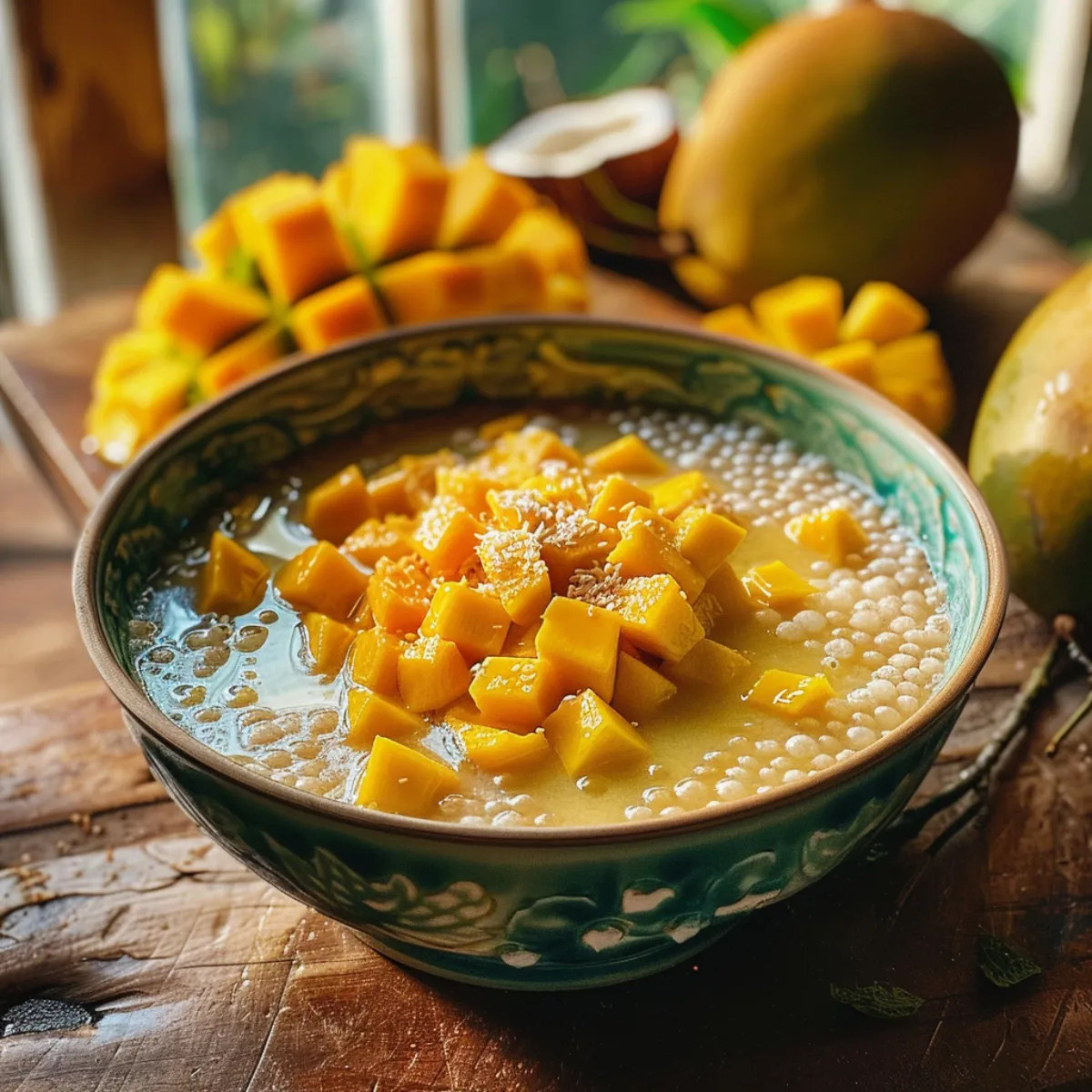
Mango sago can last up to 3 days in the refrigerator if stored in an airtight container. Here’s what you should know:
- Separate the components if possible: Store sago pearls and mango-coconut mixture separately, and only combine when serving. This helps maintain the sago’s chewy texture and prevents it from getting too soft or slimy.
- Keep it cold: Always refrigerate within 1–2 hours of preparing, especially if you used dairy-based milk like evaporated milk.
- Stir before serving: The mixture may thicken as it chills, so give it a quick stir and add a splash of coconut milk if it’s too thick.
Can You Freeze Mango Sago? Do’s and Don’ts
Freezing might seem like a handy option for leftovers—but mango sago doesn’t freeze well. Here’s why:
Don’t Freeze Fully Assembled Mango Sago
- Sago pearls turn unpleasantly hard and grainy once frozen and thawed.
- Mango purée may separate, and coconut milk can take on a weird texture.
What You Can Freeze:
- Mango Purée: If you’ve made extra, freeze it separately in ice cube trays or zip-lock bags for smoothies or future desserts.
- Cooked Sago Pearls (Unmixed): These can be frozen for a short time—1 to 2 weeks—but make sure to rinse and reheat in warm water before using.
If you’re prepping in advance, it’s best to make the mango purée and sago separately, freeze only what’s stable, and assemble fresh on the day of serving.
Up next, I’ll share a personal story behind my love for mango sago and the little tweaks I’ve made to fit my home-cooking style. Let’s get a bit personal in the final section before we jump into the FAQs.
Cultural Reflections and Personal Twist
My First Encounter with Mango Sago in Southeast Asia
It was in a small dessert café tucked between the old shophouses of Singapore where I first truly tasted mango sago. I was hot, jet-lagged, and craving something cold. A friend nudged me to try it, and I’ll never forget that first spoonful—cool, velvety mango mingling with soft sago pearls in a sea of coconut and milk. It wasn’t just dessert; it was a moment.
That bowl changed the way I thought about tropical flavors. Before that, mango had always been something I sliced and ate with chili salt back home. But this—this was mango elevated.
Since that trip, I’ve chased mango sago from Bangkok to Manila, each place putting its own fingerprint on the dessert. And each time I returned home, I felt inspired to recreate what I’d tasted. But I never aimed for perfection—only connection.
How I Adjusted the Recipe to Fit My Home Kitchen Vibe
Back in my own kitchen, mango sago has taken on a more laid-back, rustic personality—just like me. I play with coconut milk-to-mango ratios, use canned mangoes when fresh ones are out of season, and occasionally top it with crunchy bits like toasted coconut flakes or even granola.
My favorite trick? Blending in just a pinch of salt with the coconut milk. It doesn’t make the dessert salty—it makes the mango pop. I also started letting the kids spoon their own toppings, making dessert night feel like a mini sundae bar.
And you know what? That’s what cooking means to me. Not sticking to rules but adapting them. Learning through tasting. Finding joy in simple flavors—like a bowl of mango sago on a warm day with people you love.
Now that I’ve shared my story and the full recipe journey, let’s tackle some of the questions people often ask about mango sago—before wrapping up with our conclusion.
FAQs About Mango Sago
What is Mango Sago made of?
Mango sago is typically made with fresh mangoes, sago pearls, coconut milk, and evaporated milk. Some versions also include sugar, condensed milk, or even pomelo segments for extra texture. The dish is chilled and served cold, making it a refreshing tropical dessert that’s both creamy and fruity.
What is sago made of?
Sago is a starch extracted from the pith of tropical palm trees, particularly the Metroxylon sagu. Once processed, it’s formed into small white pearls that turn translucent when cooked. It’s widely used in Southeast Asian cooking, especially in desserts.
Is sago the same as tapioca?
No, sago and tapioca are not the same, although they look and cook similarly. Sago is made from palm tree pith, while tapioca is made from cassava root. Both become chewy and translucent when cooked, but sago tends to have a softer, more delicate bite compared to tapioca.
What’s the history behind Mango Sago?
Mango sago originated in Hong Kong in the 1980s, first appearing at the renowned Lei Garden restaurant. The goal was to create a light, refreshing dessert using local ingredients. Since then, it has become a popular treat across Asia, with variations found in the Philippines, Singapore, Thailand, and more.
With the questions answered, let’s wrap up everything in a sweet and sunny conclusion.
Conclusion: Why Mango Sago Deserves a Spot in Your Dessert Repertoire
From its creamy texture to its tropical burst of flavor, mango sago is more than just a dessert—it’s a refreshing experience wrapped in a bowl. Whether you first try it in a bustling café in Southeast Asia or from the comfort of your home kitchen, it’s the kind of treat that leaves a lasting impression.
What I love most is how adaptable it is. You can make it rich and indulgent or light and plant-based. You can serve it at dinner parties or as a casual family night dessert. However you make it, mango sago always manages to feel special.
So if you haven’t yet tried making it yourself, now’s the time. You don’t need fancy equipment—just a few ripe mangoes, some sago pearls, and a bit of culinary curiosity.
Follow along for more stories and recipes I love sharing on Facebook and on Pinterest, where each dish has its own tale to tell.
Print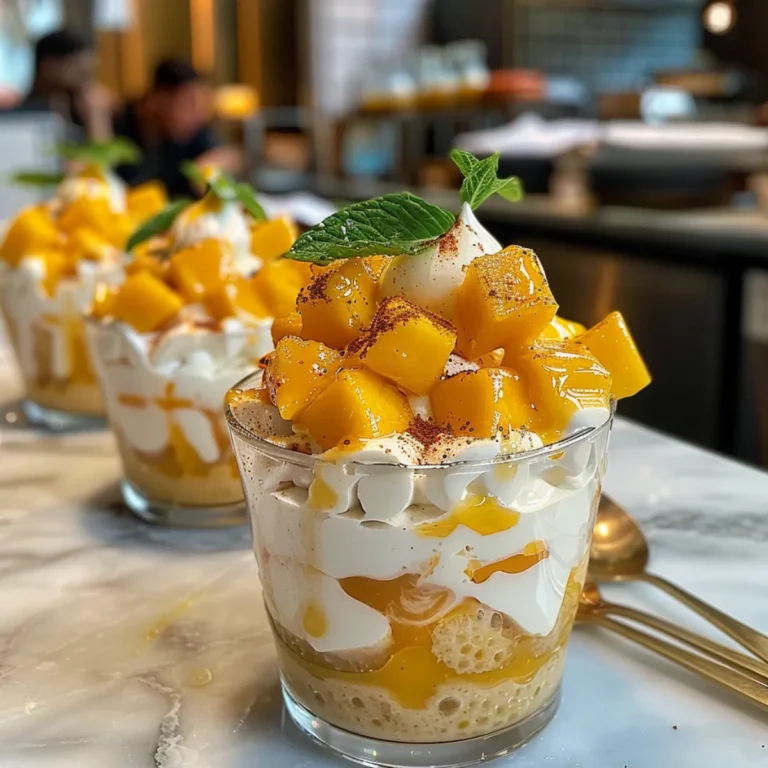
Mango Sago – A Tropical Dessert You’ll Fall in Love With
A chilled, creamy Asian dessert featuring ripe mangoes, coconut milk, and chewy sago pearls—refreshing and easy to make at home.
- Total Time: 25 minutes
- Yield: 4 servings
Ingredients
- 2 large ripe mangoes (peeled, diced, and puréed)
- ½ cup small sago pearls
- 1 cup coconut milk
- ½ cup evaporated milk
- 1–2 tbsp sugar (optional)
- 1 cup cold water or crushed ice
- Extra mango cubes for topping
Instructions
- Bring 4–5 cups of water to a boil in a medium pot. Add the sago pearls and stir gently. Boil for 10–15 minutes until pearls are mostly translucent.
- Turn off the heat, cover, and let sit for 10 minutes. Rinse under cold water and strain.
- Blend 1½ mangoes with coconut milk and sugar until smooth.
- In a large bowl, combine mango purée, evaporated milk, and cold water or ice. Stir in the cooked sago pearls.
- Chill in the fridge for 30 minutes.
- Serve in glasses or bowls. Top with extra mango cubes and a splash of coconut cream if desired.
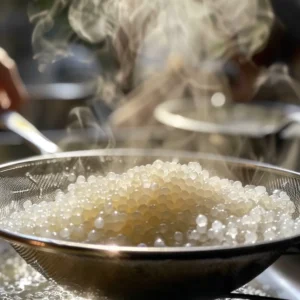
Notes
Taste your mangoes before adding sugar. Avoid overcooking sago to maintain chewiness. Chill well before serving for best flavor.
- Prep Time: 10 minutes
- Cook Time: 15 minutes
- Category: Dessert
- Method: Chilled
- Cuisine: Asian
Nutrition
- Serving Size: 1 cup
- Calories: 275
- Sugar: 22g
- Sodium: 55mg
- Fat: 10g
- Saturated Fat: 8g
- Unsaturated Fat: 2g
- Trans Fat: 0g
- Carbohydrates: 44g
- Fiber: 2g
- Protein: 3g
- Cholesterol: 5mg
